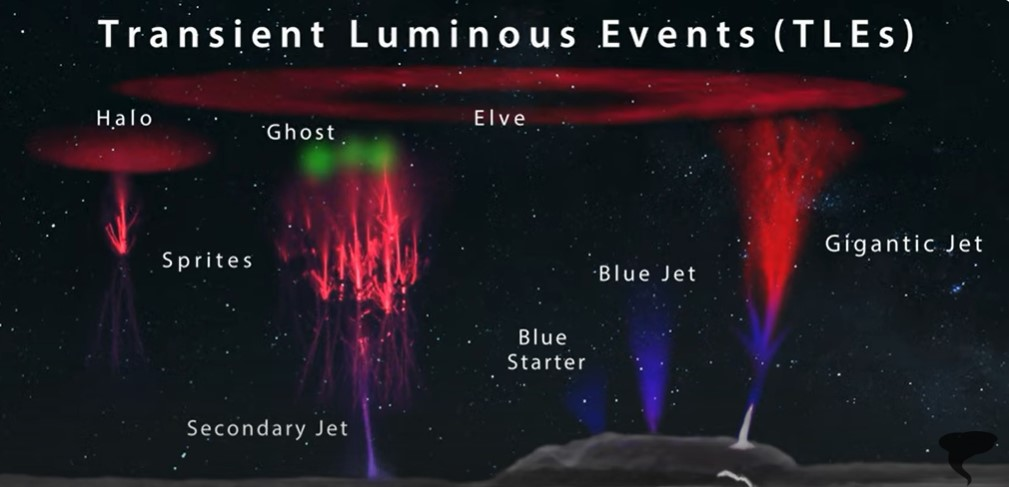Among the menagerie of types of glowing upper atmospheric phenomena, one has been named the “green ghost”. The first spectral imaging of one such ghost reveals the presence of iron and nickel in dust falling on the planet at the right time for electrical storms to produce an other-worldly glow.
Lights in the sky have been seen as long as there have been people to see them – whole religions have been dedicated to the gods considered responsible. Humanity’s expansion to higher latitudes exposed us to new types in the form of auroras. The development of flight enabled us to spot examples that can only be seen from above most of the atmosphere, and more widespread cameras have provided a chance to study what would once have just been travelers’ tales.
As a result, since 1989 we’ve discovered a zoo of high-altitude transient luminous events (TLEs) – given names such as sprites, elves, and trolls – as well as the more prosaic-sounding STEVEs and high-tech blue jets. The brief red lights dubbed sprites sometimes give birth to green glows known as ghosts. Sprites can accompany electrical storms and often look like giant jellyfish. They’re caused by electrical discharges, or in other words a particularly high-altitude form of lightning – but the ghosts have remained a mystery.
Representations of the different known types of transient luminous events
Image Credit: Institute of Astrophysics of Andalusia (IAA-CSIC)
Dr Maria Passas-Varo of Instituto de Astrofisica de Andalucia and colleagues have come not to bust these ghosts, but to explain them. That hasn’t been easy. Sprites are rare enough, and only a tiny fraction produce ghosts, leaving little opportunity to observe the phenomena. When they occur, ghosts usually last less than a second.
Many different elements can produce green emissions when heated under the right conditions. It was initially anticipated ghosts’ color was a product of oxygen atoms energized by the spritely discharges. However, after years of hunting, when the researchers were able to get a spectral sample of a ghost, most of the color turned out to be a different shade of green, one associated with iron.
“It comes from meteors that enter the atmosphere at high speed, burn up and [then] the metal atoms are left suspended. The iron layer is normally a little bit higher [than when the ghost was photographed],” Passas-Varo told El Pais.
Iron’s contribution wasn’t obvious because the two main visible iron emission lines, at 528.0 and 583.5 nm, average out to be very close to the main atomic oxygen line (557.7nm).
Some additional shades of green are provided by rarer metals in the asteroids, particularly nickel, with the emission line from atmospheric oxygen playing only a small part. Ironically, what light did come from the eighth element of the periodic table was mostly ionic molecular oxygen (590 and 599nm), not the anticipated atomic oxygen.
The reason Passas-Varo and colleagues had to photograph 42 sprites before they got one ghost is presumably because the atmosphere needs to have been recently seeded with asteroidal iron. Even when the iron is present, if it is sitting too high for the sprites to reach, a ghost won’t be seen.
While some scientists are happy enough just to give names from folklore to phenomena that appear magical, others insist on creating backronyms, however twisted, to justify the designation. Thus, Steve became Strong Thermal Emission Velocity Enhancement. The term ghost was slightly different, only coming into use after photographer Paul Smith and the first person to photograph the glow, Hank Shycma, failed to come up with an acronym that spelled out goblin. They went with “Green emissions from excited Oxygen in Sprite Tops”, with the new paper proposing “GreenisH Optical emission from Sprite Tops” instead.
The trailing h, technically making these GOSTs, is the least of the problems. As with many objects that get named before we really understand them, it turns out the original acronym is quite wrong, with Passas-Var showing oxygen plays little part in the green color. We humbly suggest that “Green emissions from exited Iron in Sprite Tops” gets to the “gist” of things, despite leaving out the contribution from nickel and other minerals, but we’re probably stuck with ghost.
The study is published open access in the journal Nature Communications
Source Link: Mysterious Green Lightning "Ghosts" Of Earth's Upper Atmosphere Have Finally Been Explained
